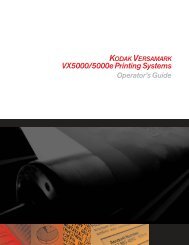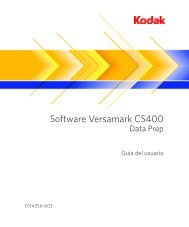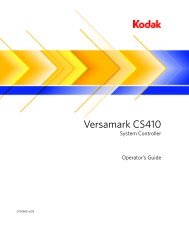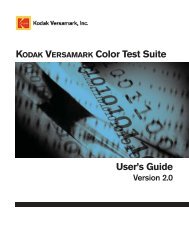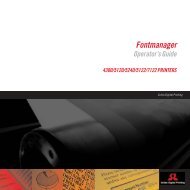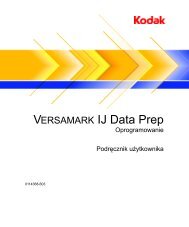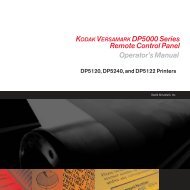You also want an ePaper? Increase the reach of your titles
YUMPU automatically turns print PDFs into web optimized ePapers that Google loves.
Fixed Files<br />
Chapter 1. Overview<br />
Fixed Files<br />
If font characters are the lowest elements on a page, the following rules<br />
apply. For a left-rotated or inverted font, the page length is one more than<br />
the Y position of the start of line. If a right-rotated font is being used, the<br />
page length is the number of dot rows up to and including the last column<br />
of the last character.<br />
The page length is determined by the last dot row used by any record on<br />
the page. Records that affect the page length are SFI, IML, SIL, UIL,<br />
SPO, SPX, SRP, SPC, BOX, CBM, and IBM. For the SFI, IML, SIL, UIL,<br />
and SPC records, the font orientation determines the effect as previously<br />
described. If a BOX, CBM, or IBM image is the lowest element on a page,<br />
the page length is the starting Y position plus the height.<br />
Instead of using the default page length based on the image data on the<br />
page as just described, you can set the page length using the SPL record.<br />
The page length can be set to be longer or shorter than the space<br />
occupied by the image data. If the length is set to be shorter than the<br />
image length, part of the image will be clipped. If the page length is set to<br />
be longer than the image length, white space is included up to the<br />
specified length.<br />
Note: The PLR won't set the page length to less than the default:<br />
4096 for printhead resolution 120 or 240 dpi;<br />
10240 for printhead resolution 300 or 600 dpi.<br />
The fixed file area is a storage area in the data station where fixed<br />
information may be kept, so that the same information does not need to<br />
be read repeatedly from the input file.<br />
Each RIP may have up to 256 fixed files, numbered from 0 to 255. Each<br />
fixed file may contain any number of records. The maximum amount of<br />
fixed file storage available is printer dependent.<br />
The fixed files for each RIP are loaded at the beginning of the job, after<br />
the fonts. The start of each fixed file is indicated by an LFF record. The<br />
LFF record is not stored as part of the fixed file. The end of the last fixed<br />
file for each RIP is indicated by an EFF record. All records between the<br />
first LFF and the EFF for each RIP are stored in the fixed file area, except<br />
for the LFF, EFF, and RIP records.<br />
During generation of documents, the data station maintains a pointer to<br />
the current position of each fixed file for each RIP. At the start of a<br />
document, all the pointers are reset to the start of their respective fixed<br />
files. During processing of a document, the pointers may be changed, and<br />
records stored in the fixed files may be executed, by use of the SFF, GFF,<br />
and RFF commands.<br />
Refer to Chapter 5 for a list of the records allowed in the fixed files.<br />
Reference Guide 1 - 15





